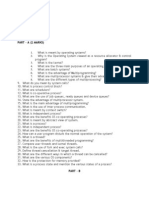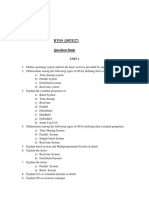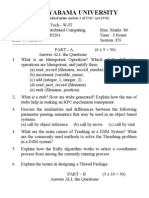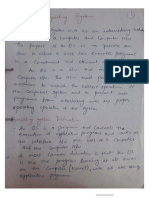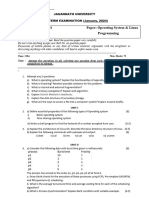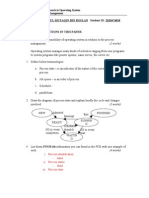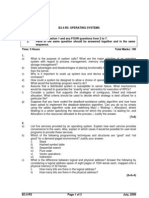0 ratings0% found this document useful (0 votes)
79 viewsUnit 6: Real Time Operating System For Microcontrollers
Unit 6: Real Time Operating System For Microcontrollers
Uploaded by
Amarnath GainiThe document discusses real-time operating systems for microcontrollers. It covers scheduling strategies for periodic, aperiodic, and sporadic tasks, how preemptive events occur, advantages of time slice scheduling, how an RTOS handles interrupts in a multitasking environment, kernel architecture and objects, task states, synchronization strategies between tasks and interrupts, process descriptors and control blocks, round robin preemptive multitasking, interrupt latency and response/recovery times, advantages of dividing applications into tasks and task control blocks, mailboxes and message passing between tasks, initiating round robin scheduling and examples of its use, preemptive scheduling and assigning priorities, and functions of RTOSs in RT_X and RT_X51.
Copyright:
Attribution Non-Commercial (BY-NC)
Available Formats
Download as DOCX, PDF, TXT or read online from Scribd
Unit 6: Real Time Operating System For Microcontrollers
Unit 6: Real Time Operating System For Microcontrollers
Uploaded by
Amarnath Gaini0 ratings0% found this document useful (0 votes)
79 views1 pageThe document discusses real-time operating systems for microcontrollers. It covers scheduling strategies for periodic, aperiodic, and sporadic tasks, how preemptive events occur, advantages of time slice scheduling, how an RTOS handles interrupts in a multitasking environment, kernel architecture and objects, task states, synchronization strategies between tasks and interrupts, process descriptors and control blocks, round robin preemptive multitasking, interrupt latency and response/recovery times, advantages of dividing applications into tasks and task control blocks, mailboxes and message passing between tasks, initiating round robin scheduling and examples of its use, preemptive scheduling and assigning priorities, and functions of RTOSs in RT_X and RT_X51.
Original Description:
microcontrollers and applications
Original Title
Unit 6
Copyright
© Attribution Non-Commercial (BY-NC)
Available Formats
DOCX, PDF, TXT or read online from Scribd
Share this document
Did you find this document useful?
Is this content inappropriate?
The document discusses real-time operating systems for microcontrollers. It covers scheduling strategies for periodic, aperiodic, and sporadic tasks, how preemptive events occur, advantages of time slice scheduling, how an RTOS handles interrupts in a multitasking environment, kernel architecture and objects, task states, synchronization strategies between tasks and interrupts, process descriptors and control blocks, round robin preemptive multitasking, interrupt latency and response/recovery times, advantages of dividing applications into tasks and task control blocks, mailboxes and message passing between tasks, initiating round robin scheduling and examples of its use, preemptive scheduling and assigning priorities, and functions of RTOSs in RT_X and RT_X51.
Copyright:
Attribution Non-Commercial (BY-NC)
Available Formats
Download as DOCX, PDF, TXT or read online from Scribd
Download as docx, pdf, or txt
0 ratings0% found this document useful (0 votes)
79 views1 pageUnit 6: Real Time Operating System For Microcontrollers
Unit 6: Real Time Operating System For Microcontrollers
Uploaded by
Amarnath GainiThe document discusses real-time operating systems for microcontrollers. It covers scheduling strategies for periodic, aperiodic, and sporadic tasks, how preemptive events occur, advantages of time slice scheduling, how an RTOS handles interrupts in a multitasking environment, kernel architecture and objects, task states, synchronization strategies between tasks and interrupts, process descriptors and control blocks, round robin preemptive multitasking, interrupt latency and response/recovery times, advantages of dividing applications into tasks and task control blocks, mailboxes and message passing between tasks, initiating round robin scheduling and examples of its use, preemptive scheduling and assigning priorities, and functions of RTOSs in RT_X and RT_X51.
Copyright:
Attribution Non-Commercial (BY-NC)
Available Formats
Download as DOCX, PDF, TXT or read online from Scribd
Download as docx, pdf, or txt
You are on page 1of 1
UNIT 6
REAL TIME OPERATING SYSTEM FOR MICROCONTROLLERS
1. (a) How do you choose scheduling strategy for the periodic, aperiodic and sporadic tasks? (b) How does a preemptive event occur? 2. (a) What are the advantages of time slice scheduling by an RTOS (b) Explain three ways in which an RTOS handles the ISRS in a multitasking environment 3. (a) Explain the basic architecture of the kernel. What are the kernel objects? (b) With the help of state diagram explain different task states 4. (a) List the best strategies for synchronization between the tasks and ISRS. (b) Explain the terms process descriptor and process control block 5. (a) Explain Round robin pre emptive multi-tasking algorithm. (b) Explain Interrupt latency, interrupt response time and interrupt recovery time in real time operating system. 6. (a) What are the advantages of dividing an application into multiple tasks? What is a task control block? (b) Explain the mailbox. Show how a task sends message to another task waiting for the message to start. Also show how a task sends a message pointer to another task waiting for that to start. 7. How do we initiate round robin time slice scheduling? Give atleast two examples of the need for round robin scheduling. 8. How do we initiate pre emptive scheduling and assign prioritieus to the tasks for scheduling? Give two examples of the need for pre emptive scheduling? 9. (a) How do you choose scheduling strategy for the periodic, aperiodic and sporadic tasks? (b) How does a preemptive event occur? 10. Explain the RTOs functions in RT _X and RT _ X51 full.
You might also like
- CS1252 Operating SystemsDocument6 pagesCS1252 Operating SystemsNagarajan m SNo ratings yet
- Gandhinagar Institute of Technology: Computer Engineering DepartmentDocument6 pagesGandhinagar Institute of Technology: Computer Engineering Departmentshah mananNo ratings yet
- Exam 2012Document5 pagesExam 2012Omer PolatNo ratings yet
- OPERATING SYSTEM I Exam QuestionDocument2 pagesOPERATING SYSTEM I Exam QuestionAmaonwu OnyebuchiNo ratings yet
- Semester:-Sem IV Branch: - Computer Science and Engineering Subject: - Operating SystemDocument14 pagesSemester:-Sem IV Branch: - Computer Science and Engineering Subject: - Operating SystemYash SugandhiNo ratings yet
- Os Latest 5 Years QuestionDocument4 pagesOs Latest 5 Years Questionnikhilmahato526No ratings yet
- Amrapali Institute of Applied Sciences: Note-Attempt Any Five Question. All Question Carry Equal MarksDocument1 pageAmrapali Institute of Applied Sciences: Note-Attempt Any Five Question. All Question Carry Equal MarksSuresh WariyalNo ratings yet
- RTOS Assignment Module WiseDocument3 pagesRTOS Assignment Module WisesadiqueNo ratings yet
- Unit - I Part - A (2 Marks)Document9 pagesUnit - I Part - A (2 Marks)kashokcse16No ratings yet
- OS Question Bank 1Document10 pagesOS Question Bank 1Murali SkpecNo ratings yet
- Operating Systems Question Bank For TwoDocument15 pagesOperating Systems Question Bank For Twovkalaiselvi.engineeringNo ratings yet
- University of Glasgow: Thursday, May 10, 2007 2:30p.m. - 4:15p.mDocument5 pagesUniversity of Glasgow: Thursday, May 10, 2007 2:30p.m. - 4:15p.mnskprasad89No ratings yet
- RTOS question bank (2)Document3 pagesRTOS question bank (2)Govardhan NagendraNo ratings yet
- M. C. A. (Revised) Term-End Examination June, 2019: Mcs-041: Operating SystemsDocument3 pagesM. C. A. (Revised) Term-End Examination June, 2019: Mcs-041: Operating Systemsbikash PrajapatiNo ratings yet
- RTOS Question Bank-1Document13 pagesRTOS Question Bank-1SIDDESHWAR VASAM0% (1)
- sathyabama-IIsem-Distributed Computing-683201-783201Document2 pagessathyabama-IIsem-Distributed Computing-683201-783201ShankarNo ratings yet
- SPC 2201 Operating Systems I Year II Semester IIDocument3 pagesSPC 2201 Operating Systems I Year II Semester IInyakundip11No ratings yet
- Visnu Assignment 2Document6 pagesVisnu Assignment 2Visnu ManimaranNo ratings yet
- AugustSeptember 2021Document1 pageAugustSeptember 2021Ruha JabeenNo ratings yet
- 2023 Os Model QPDocument16 pages2023 Os Model QPbjbhargav600No ratings yet
- Rts QuestionsDocument3 pagesRts QuestionsRaju RanjanNo ratings yet
- LINUX ASSIGNMENT 1 and 2Document1 pageLINUX ASSIGNMENT 1 and 2gbpatel.didsNo ratings yet
- OSDocument148 pagesOSA K SharmaNo ratings yet
- ALM1Document2 pagesALM1hexoka9508No ratings yet
- Os Fiat ImportDocument5 pagesOs Fiat ImportBhavani SureshNo ratings yet
- OsDocument3 pagesOsaditipatil2404No ratings yet
- Fourth Semester B.Tech Degree Examination July 2021 (2019 Scheme)Document3 pagesFourth Semester B.Tech Degree Examination July 2021 (2019 Scheme)Jessel CherianNo ratings yet
- Os Paper AllDocument6 pagesOs Paper Allgojoo.saatoruNo ratings yet
- Capability Based Addressing?Document3 pagesCapability Based Addressing?sindu_lawrenceNo ratings yet
- Summer 2023Document1 pageSummer 202303krushita gajeraNo ratings yet
- Operating Systems April Exam 2024Document3 pagesOperating Systems April Exam 2024Harris ChikunyaNo ratings yet
- Eee-Nd-2021-Cs 2411-Operating Systems-115487051-80395 (CS2411-CS609)Document3 pagesEee-Nd-2021-Cs 2411-Operating Systems-115487051-80395 (CS2411-CS609)VIGNESH MNo ratings yet
- 10 M Os Question BankDocument4 pages10 M Os Question Bankrifathmuzammilshaik24No ratings yet
- OS Unit Test-1Document1 pageOS Unit Test-1psrivatsan407No ratings yet
- Code No: 45027Document5 pagesCode No: 45027SRINIVASA RAO GANTANo ratings yet
- PictureDocument1 pagePictureHemalatha AnandhanNo ratings yet
- OS Question BankDocument4 pagesOS Question BankStardombioNo ratings yet
- Code No: 27193Document8 pagesCode No: 27193SRINIVASA RAO GANTANo ratings yet
- Cpu Scheduling AssignmentDocument3 pagesCpu Scheduling AssignmentJoséphNo ratings yet
- Gujarat Technological UniversityDocument2 pagesGujarat Technological Universityypgcloud1No ratings yet
- Operating System Important QuestionsDocument3 pagesOperating System Important Questionsskhamshu22f01a4456No ratings yet
- Dist - Model PaperDocument2 pagesDist - Model PaperManasa GeervaniNo ratings yet
- CS2254 QBDocument7 pagesCS2254 QBkuttymythuNo ratings yet
- Past Paper Question StudentDocument5 pagesPast Paper Question StudentminedeathpcNo ratings yet
- Operating Systems Important QuestionsDocument7 pagesOperating Systems Important Questionsdrme.studio2020No ratings yet
- Goup Assignment EE 8403-2024Document5 pagesGoup Assignment EE 8403-2024Hezron gibronNo ratings yet
- Jagannath University PaperDocument2 pagesJagannath University PapergeetaNo ratings yet
- Important Questions in Mobile Communication It2402 It 2402 Subject For NovDocument3 pagesImportant Questions in Mobile Communication It2402 It 2402 Subject For NovNivedhaSekarNo ratings yet
- RtesDocument6 pagesRteschaitanyaNo ratings yet
- WT - Te - 2019 - Endsem 2022-23Document2 pagesWT - Te - 2019 - Endsem 2022-23mohamed mowafeyNo ratings yet
- Assignment Process ManagementDocument5 pagesAssignment Process ManagementAmirul MutaqinNo ratings yet
- Os Question Bank-1Document6 pagesOs Question Bank-1suprajdeshikNo ratings yet
- Operating System 150 MarksDocument4 pagesOperating System 150 MarksShreyashNo ratings yet
- 21cs44 Os - Simp 2023 (For 21 Scheme Only) - TieDocument2 pages21cs44 Os - Simp 2023 (For 21 Scheme Only) - TieBangalore Naga SuvidhyaNo ratings yet
- B34 R3Document3 pagesB34 R3Hari KalathilNo ratings yet
- May 2018Document25 pagesMay 2018RAAJ KISHOR R HNo ratings yet
- Operating System (MCA 505) (Makeup)Document2 pagesOperating System (MCA 505) (Makeup)lalendrakumar170No ratings yet
- GainiDocument1 pageGainiAmarnath GainiNo ratings yet
- Blind Deconvolution Algorithm For Image Restoration Using Point Spread FunctionDocument5 pagesBlind Deconvolution Algorithm For Image Restoration Using Point Spread FunctionAmarnath GainiNo ratings yet
- Multi-Level Cell Flash Memory Storage Systems: Amarnath Gaini Sathish Mothe K VijayalaxmiDocument7 pagesMulti-Level Cell Flash Memory Storage Systems: Amarnath Gaini Sathish Mothe K VijayalaxmiAmarnath GainiNo ratings yet
- Computer Organisation: Topic To Be Covered No - of Periods Required Basic Structure OF Computers: Computer TypesDocument4 pagesComputer Organisation: Topic To Be Covered No - of Periods Required Basic Structure OF Computers: Computer TypesAmarnath GainiNo ratings yet








